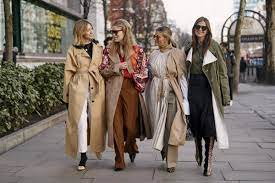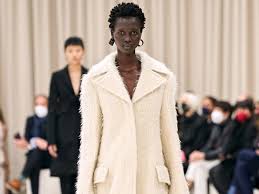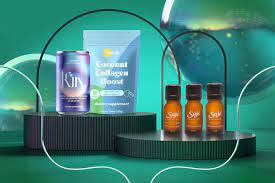Elevate Your Style: The Ultimate Guide to Women’s Fashion Trends
The Ever-Evolving World of Women’s Fashion
Women’s fashion is a dynamic and ever-changing industry that reflects the diverse tastes and personalities of women around the world. From classic styles to bold statements, there is something for everyone in the world of fashion.
Trending Styles for the Season
This season, we are seeing a resurgence of retro-inspired looks, with bold colours and patterns making a comeback. From polka dots to floral prints, there is no shortage of options for those looking to make a statement with their wardrobe.
On the other end of the spectrum, minimalist and monochromatic looks continue to be popular choices for those who prefer a more understated style. Clean lines, neutral tones, and simple silhouettes are key elements of this timeless aesthetic.
Must-Have Accessories
No outfit is complete without the right accessories. This season, statement jewellery is taking centre stage, with oversized earrings and chunky necklaces adding a touch of glamour to any ensemble. Belts are also making a comeback, cinching waists and adding definition to outfits.
When it comes to footwear, comfort is key. Chunky sneakers and stylish flats are all the rage this season, offering both style and practicality for women on the go.
Embracing Individuality
One of the most exciting aspects of women’s fashion is its ability to empower individuals to express their unique personalities through clothing. Whether you prefer bold prints or classic cuts, there are endless possibilities for creating your own signature style.
Ultimately, women’s fashion is about self-expression, creativity, and confidence. It’s about embracing who you are and celebrating your individuality through what you wear. So go ahead, experiment with different styles, mix and match pieces, and have fun expressing yourself through fashion!
Five Empowering Benefits of Women’s Fashion: Creativity, Trends, Confidence, Diversity, and Quality Investment
- Women’s fashion allows for self-expression and creativity through clothing choices.
- Fashion trends provide an opportunity to stay updated with the latest styles and looks.
- Well-chosen outfits can boost confidence and enhance one’s self-image.
- Women’s fashion offers a wide range of options to suit different preferences, body types, and occasions.
- Investing in quality wardrobe pieces can lead to long-lasting, versatile styling options.
Six Critical Concerns in Women’s Fashion: From Ethical Issues to Environmental Impact
- Pressure to constantly keep up with changing trends
- High cost of designer and luxury fashion items
- Limited sizing options in some brands and stores
- Promotion of unrealistic body standards through certain fashion campaigns
- Environmental impact of fast fashion and clothing waste
- Potential for exploitation of garment workers in the fashion industry
Women’s fashion allows for self-expression and creativity through clothing choices.
Women’s fashion provides a powerful platform for women to express themselves and unleash their creativity through their clothing choices. Whether it’s experimenting with different styles, mixing and matching pieces, or incorporating unique accessories, fashion allows women to showcase their individuality and personality. From bold statements to subtle nuances, the way a woman dresses can convey her mood, preferences, and even her values. By embracing the freedom to express themselves through fashion, women can truly celebrate their uniqueness and showcase their personal style to the world.
Fashion trends provide an opportunity to stay updated with the latest styles and looks.
Fashion trends in women’s fashion provide a valuable opportunity to stay abreast of the latest styles and looks. By keeping up with current trends, women can refresh their wardrobe, experiment with new aesthetics, and explore different ways to express their personal style. Embracing fashion trends allows individuals to stay relevant in the ever-evolving world of fashion and feel confident in their appearance. It offers a chance to be inspired by innovative designs and incorporate them into one’s own wardrobe, creating a sense of excitement and creativity in everyday dressing.
Well-chosen outfits can boost confidence and enhance one’s self-image.
Selecting the right outfits in women’s fashion can have a remarkable impact on confidence and self-image. When a woman feels comfortable and stylish in what she wears, it radiates through her demeanor, boosting her self-assurance and overall sense of empowerment. The perfect outfit can accentuate her best features, highlight her personality, and make her feel ready to conquer the day with poise and flair. Women’s fashion has the incredible ability to not only adorn the body but also uplift the spirit, allowing individuals to showcase their unique identity with pride and confidence.
Women’s fashion offers a wide range of options to suit different preferences, body types, and occasions.
Women’s fashion is a versatile and inclusive realm that caters to a diverse range of preferences, body types, and occasions. Whether you prefer a casual and laid-back style or a more formal and elegant look, there are endless options available to suit your individual taste. From flowy dresses for summer picnics to tailored suits for professional events, women’s fashion embraces variety and offers something for every woman, regardless of her shape or size. This flexibility allows women to express themselves authentically and confidently in any setting they find themselves in.
Investing in quality wardrobe pieces can lead to long-lasting, versatile styling options.
Investing in quality wardrobe pieces in women’s fashion can be a game-changer, offering a multitude of benefits. By opting for well-made, timeless pieces, women can enjoy long-lasting durability and versatility in their styling options. Quality garments not only stand the test of time but also provide endless possibilities for mixing and matching, creating various looks for different occasions. From classic tailored blazers to elegant silk blouses, these investment pieces serve as the building blocks of a versatile wardrobe that effortlessly transitions from day to night with style and sophistication.
Pressure to constantly keep up with changing trends
One significant drawback of women’s fashion is the relentless pressure to constantly stay up-to-date with the ever-changing trends. This pressure can lead to a sense of insecurity and inadequacy, as women feel the need to constantly refresh their wardrobe to match the latest styles. The fast-paced nature of the fashion industry can be overwhelming, causing stress and financial strain as individuals strive to keep pace with fleeting trends. This constant need to keep up can detract from the joy of self-expression through clothing, turning a creative outlet into a source of anxiety for many women.
High cost of designer and luxury fashion items
The high cost of designer and luxury fashion items can be a significant drawback in the world of women’s fashion. While these items often boast exquisite craftsmanship and exclusive designs, their price tags can put them out of reach for many individuals. This exclusivity can create a sense of elitism within the industry, making it challenging for those with limited budgets to access the latest trends and styles. Additionally, the emphasis on luxury fashion can perpetuate a culture of materialism and consumerism, where the value of clothing is based on its brand name rather than its quality or design. As a result, the high cost of designer fashion items can contribute to widening inequalities and promoting unsustainable shopping habits.
Limited sizing options in some brands and stores
One significant drawback in women’s fashion industry is the limited sizing options offered by some brands and stores. This exclusionary practice can make it challenging for many women to find clothing that fits them comfortably and flatters their body shape. It reinforces unrealistic beauty standards and can lead to feelings of inadequacy and self-consciousness among those who do not fit into the narrow size range provided. By not catering to a diverse range of body types, these brands and stores are missing out on the opportunity to empower all women to feel confident and stylish in their own skin.
Promotion of unrealistic body standards through certain fashion campaigns
Certain fashion campaigns in the women’s fashion industry have been criticised for promoting unrealistic body standards, which can have a negative impact on women’s self-esteem and body image. By showcasing only a narrow range of body types that often do not represent the diversity of real women, these campaigns contribute to the perpetuation of unattainable beauty ideals. This can lead to feelings of inadequacy and pressure to conform to a certain standard of beauty, potentially harming women’s mental and emotional well-being. It is important for the fashion industry to embrace diversity and promote body positivity to ensure that all women feel represented and valued.
Environmental impact of fast fashion and clothing waste
The environmental impact of fast fashion and clothing waste is a significant con of women’s fashion industry. The constant demand for cheap, trendy clothing has led to overproduction, excessive waste, and harmful practices that contribute to environmental degradation. From the use of non-biodegradable materials to the release of toxic chemicals during production, fast fashion has a detrimental effect on our planet. Additionally, the disposal of unwanted clothes adds to the growing issue of textile waste in landfills. It is crucial for both consumers and industry stakeholders to address these challenges and work towards more sustainable and ethical practices in order to minimise the negative impact on our environment.
Potential for exploitation of garment workers in the fashion industry
The potential for exploitation of garment workers in the fashion industry is a concerning con of women’s fashion. Behind the glamour and allure of trendy clothing lies a harsh reality where many garment workers, predominantly women, endure poor working conditions, low wages, and long hours to meet the demands of fast fashion. The pressure to produce clothing quickly and cheaply often leads to unethical practices within the supply chain, with workers bearing the brunt of these injustices. Addressing this issue is crucial to ensure that women’s fashion is not built on the exploitation of vulnerable individuals but rather on principles of fairness, dignity, and respect for all those involved in creating the clothes we wear.



